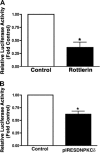Protein kinase Cdelta regulates endothelial nitric oxide synthase expression via Akt activation and nitric oxide generation
- PMID: 18192589
- PMCID: PMC3970932
- DOI: 10.1152/ajplung.00353.2007
Protein kinase Cdelta regulates endothelial nitric oxide synthase expression via Akt activation and nitric oxide generation
Retraction in
-
Retraction. Protein kinase Cδ regulates endothelial nitric oxide synthase expression via Akt activation and nitric oxide generation.Am J Physiol Lung Cell Mol Physiol. 2011 Dec;301(6):L1006. doi: 10.1152/ajplung.zh5-6007-corr.2011. Am J Physiol Lung Cell Mol Physiol. 2011. PMID: 22142987 Free PMC article. No abstract available.
Abstract
In this study, we explore the roles of the delta isoform of PKC (PKCdelta) in the regulation of endothelial nitric oxide synthase (eNOS) activity in pulmonary arterial endothelial cells isolated from fetal lambs (FPAECs). Pharmacological inhibition of PKCdelta with either rottlerin or with the peptide, deltaV1-1, acutely attenuated NO production, and this was associated with a decrease in phosphorylation of eNOS at Ser1177 (S1177). The chronic effects of PKCdelta inhibition using either rottlerin or the overexpression of a dominant negative PKCdelta mutant included the downregulation of eNOS gene expression that was manifested by a decrease in both eNOS promoter activity and protein expression after 24 h of treatment. We also found that PKCdelta inhibition blunted Akt activation as observed by a reduction in phosphorylated Akt at position Ser473. Thus, we conclude that PKCdelta is actively involved in the activation of Akt. To determine the effect of Akt on eNOS signaling, we overexpressed a dominant negative mutant of Akt and determined its effect of NO generation, eNOS expression, and phosphorylation of eNOS at S1177. Our results demonstrated that Akt inhibition was associated with decreased NO production that correlated with reduced phosphorylation of eNOS at S1177, and decreased eNOS promoter activity. We next evaluated the effect of endogenously produced NO on eNOS expression by incubating FPAECs with the eNOS inhibitor 2-ethyl-2-thiopseudourea (ETU). ETU significantly inhibited NO production, eNOS promoter activity, and eNOS protein levels. Together, our data indicate involvement of PKCdelta-mediated Akt activation and NO generation in maintaining eNOS expression.
Figures









Similar articles
-
Endothelial Cell Autophagy Maintains Shear Stress-Induced Nitric Oxide Generation via Glycolysis-Dependent Purinergic Signaling to Endothelial Nitric Oxide Synthase.Arterioscler Thromb Vasc Biol. 2017 Sep;37(9):1646-1656. doi: 10.1161/ATVBAHA.117.309510. Epub 2017 Jul 6. Arterioscler Thromb Vasc Biol. 2017. PMID: 28684613 Free PMC article.
-
Shear stress stimulates nitric oxide signaling in pulmonary arterial endothelial cells via a reduction in catalase activity: role of protein kinase C delta.Am J Physiol Lung Cell Mol Physiol. 2010 Jan;298(1):L105-16. doi: 10.1152/ajplung.00290.2009. Epub 2009 Nov 6. Am J Physiol Lung Cell Mol Physiol. 2010. PMID: 19897742 Free PMC article.
-
Endothelin-1 impairs nitric oxide signaling in endothelial cells through a protein kinase Cdelta-dependent activation of STAT3 and decreased endothelial nitric oxide synthase expression.DNA Cell Biol. 2009 Nov;28(11):543-53. doi: 10.1089/dna.2009.0865. DNA Cell Biol. 2009. PMID: 19754268 Free PMC article.
-
Endothelial nitric oxide synthase-derived nitric oxide in the regulation of metabolism.F1000Res. 2020 Oct 1;9:F1000 Faculty Rev-1190. doi: 10.12688/f1000research.19998.1. eCollection 2020. F1000Res. 2020. PMID: 33042519 Free PMC article. Review.
-
Current therapeutic strategies to mitigate the eNOS dysfunction in ischaemic stroke.Cell Mol Neurobiol. 2012 Apr;32(3):319-36. doi: 10.1007/s10571-011-9777-z. Epub 2011 Dec 25. Cell Mol Neurobiol. 2012. PMID: 22198555 Free PMC article. Review.
Cited by
-
Mechanisms and consequences of endothelial nitric oxide synthase dysfunction in hypertension.J Hypertens. 2015 Jun;33(6):1128-36. doi: 10.1097/HJH.0000000000000587. J Hypertens. 2015. PMID: 25882860 Free PMC article. Review.
-
deltaPKC inhibition or varepsilonPKC activation repairs endothelial vascular dysfunction by regulating eNOS post-translational modification.J Mol Cell Cardiol. 2010 Apr;48(4):746-56. doi: 10.1016/j.yjmcc.2009.11.002. Epub 2009 Nov 11. J Mol Cell Cardiol. 2010. PMID: 19913548 Free PMC article.
-
Novel regulators of endothelial barrier function.Am J Physiol Lung Cell Mol Physiol. 2014 Dec 15;307(12):L924-35. doi: 10.1152/ajplung.00318.2014. Epub 2014 Nov 7. Am J Physiol Lung Cell Mol Physiol. 2014. PMID: 25381026 Free PMC article. Review.
-
ADP signaling in vascular endothelial cells: ADP-dependent activation of the endothelial isoform of nitric-oxide synthase requires the expression but not the kinase activity of AMP-activated protein kinase.J Biol Chem. 2009 Nov 20;284(47):32209-24. doi: 10.1074/jbc.M109.032656. Epub 2009 Sep 25. J Biol Chem. 2009. PMID: 19783664 Free PMC article.
-
Modulation of PKCdelta signaling alters the shear stress-mediated increases in endothelial nitric oxide synthase transcription: role of STAT3.Am J Physiol Lung Cell Mol Physiol. 2009 Mar;296(3):L519-26. doi: 10.1152/ajplung.90534.2008. Epub 2008 Dec 31. Am J Physiol Lung Cell Mol Physiol. 2009. PMID: 19118090 Free PMC article.
References
-
- Ahn BK, Jeong SK, Kim HS, Choi KJ, Seo JT, Choi EH, Ahn SK, Lee SH. Rottlerin, a specific inhibitor of protein kinase C-delta, impedes barrier repair response by increasing intracellular free calcium. J Invest Dermatol 126: 1348–1355, 2006 - PubMed
-
- Boo YC, Jo H. Flow-dependent regulation of endothelial nitric oxide synthase: role of protein kinases. Am J Physiol Cell Physiol 285: C499–C508, 2003 - PubMed
-
- Boo YC, Sorescu G, Boyd N, Shiojima I, Walsh K, Du J, Jo H. Shear stress stimulates phosphorylation of endothelial nitric-oxide synthase at Ser1179 by Akt-independent mechanisms: role of protein kinase A. J Biol Chem 277: 3388–3396, 2002 - PubMed
Publication types
MeSH terms
Substances
Grants and funding
LinkOut - more resources
Full Text Sources
Research Materials

